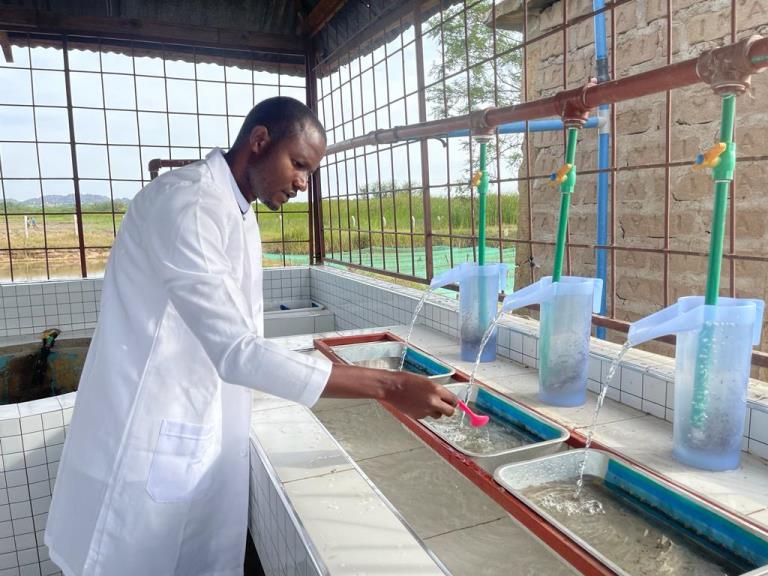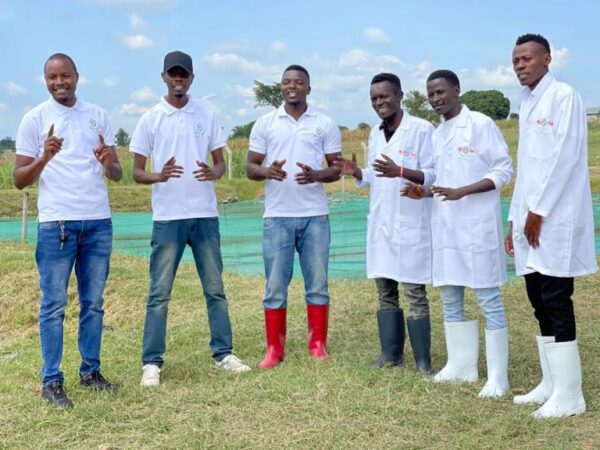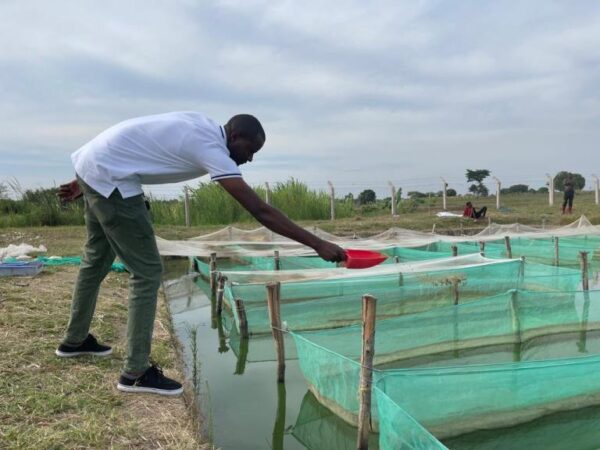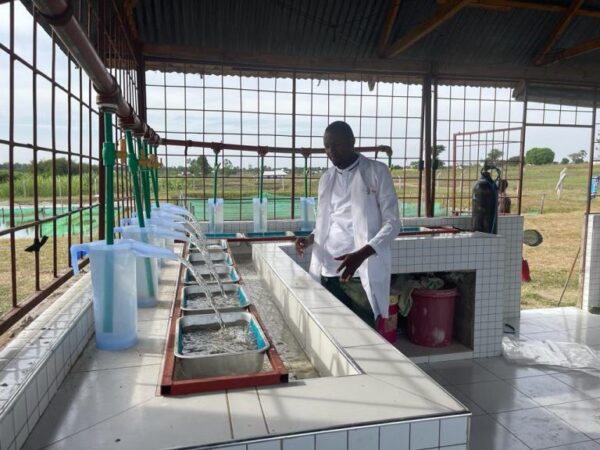
Features
Genetics Week
Hatchery Operations
Tanzania’s aquaculture revolution from humble beginnings
Elpidius Mpanju has raised his company’s initial capital of $400 in 2016 to $300,000 as of 2023
August 16, 2023 By Bob Atwiine
 Elpidius Mpanju feeding fries in hatching jars located in Mwasonge, Misungwi District. (Photo: Bob Atwiine)
Elpidius Mpanju feeding fries in hatching jars located in Mwasonge, Misungwi District. (Photo: Bob Atwiine) Elpidius Mpanju is the pioneer of the aquaculture business and the first person in his country Tanzania to be granted a permit to farm fish in cages by theestablish in 2016. He is the managing director and founder of My Fish Tanzania Company.
Mpanju’s journey which starts from being unemployed after his university in 2011, borrowing a land for his first fish pond to growing his tilapia farm to become Tanzania’s largest fish farm and hatchery operator producing a million fingerlings as well as over 10 tonnes of market-sized fish every month is a tale that can inspire many young fish farmers to aim at the glass ceiling and beyond.
Highlights
Mpanju says he operates 64 fishing cages at Kisoko area in Luchelele Ward, Nyamagana District in Mwanza Region and a hatchery at Mwasonge, Misungwi District.
“We deal in fish farming projects in general including sale of aquaculture inputs, consultations on fish farming but mainly we focus on producing fingerlings” Mpanju says.
A graduate of public relations and marketing, Mpanju told Hatchery International that in struggling looking for a livelihood, he finally found himself as a commercial fish farmer and breeder employing more than 20 fellow youth and among them six are experts in aquaculture.
“After my graduation, with no job, while I was on the internet surfing for opportunities, I learnt about fish farming and decided to give it a try. I went to a nearby college teaching fisheries and I acquired some basic knowledge about fish farming and pond construction,” he narrates.
Because Mpanju was a young man with no capital to start a fish farming business, he decided to approach and convince someone who had suitable land near the water body who also agreed to share profits from every harvest. This led to the birth of today’s My Fish Tanzania concept.
He further narrates that at the time he started, there was nowhere in Tanzania where he could get fingerings and so he had to travel out of the country to establish farms in neighbouring Uganda.
His 64 cages are around 500 m from the shore and include 5x5x5 metre square cages, and three sizes of circular cages: 13×7 metres, 10×7 metres, and 7×10 metres. The lake is 12 metres deep where he farms.
Mpanju has also managed the raise the company from an initial capital of US$424 in 2016 to about US$300,000 as of 2023.

Elpidius Mpanju together with his staff at his fish breeding site in Mwanza Region (Photo: Bob Atwiine)
Hatchery operations
In his five-pond hatchery located 10 kilometres from the growout farm, Mpanju says he is producing 1000,000 of 2-gram fingerings per month which he supplies to local farmers and as well as for his own operations.
According to Mpanju, he loses between 5 to 10 per cent from fry to fingerling size during the nursery stage.
He attributes this mortality rate to rise in water temperature due to lack of electricity to cool the water thus making it expensive to run the operations with motor generators because of high gas prices.
“Yes, there are some challenges in our hatchery but we are trying to tackle them. For example we have installed the bio-filters to deal with pathogens by making sure that water coming from the lake to the hatchery is clean and free from foreign materials,” Mpanju reflects.
He goes on to explain that as a result of unclean water, the farm has faced challenges of bacterial infections where many eggs were dying because of being attacked by the fungi noting that if he had a UV system, the challenge of mortality rates would be going down.

Mpanju feeds fingerlings in the hatcheries (Photo: Bob Atwiine)
Broodstock selection
He notes that his key to maintenance and selection of brood stock has been making sure that he gets the right source of mothers. As a result, Mpanju imports Genetically Improved Farmed Tilapia (GIFT) and Big Nin strain broodstock from Nam Sei farms in Bangkok Thailand. This was after a waiver by his government which is keen on seeing the industry grow and shine.
Mpanju explains that these strains with perfect growing conditions on Lake Victoria are able to grow in cages from two grams to 600 grams in only six months with feed conversion ratio of 1:3.
Tackling biosecurity issues
He notes that he ensures good aquatic environment through providing his fish with good quality feeds that do not sink and ensuring quality and clean water in the hatchery and pond environments.
Mpanju says with the availability of funds, he would be able to move the hatchery from ponds to an indoor Recirculating Aquaculture System (RAS) facility.
“It would be very expensive, but easier to manage, would improve the quality of our fingerlings and also require less area than the ponds.”
Diseases
According to Mpanju’s experience, there are no serious fish diseases disturbing him at the farm apart from the fungal and bacterial infections.
“What we face most is fungal infections which happen when we are transferring fish either from the nursery cages to grow out cages and fish are injured. It also happens when the fish are attacked by the predators like otters. Here, we treat them using potassium permanganate or rock salt,” he reveals before adding that the Otter predatory challenge has been solved by putting up special predator nets and covering the pens very well.
Apart from diseases, Mpanju notes that early this year the farm had a natural disaster where something strange occurred in the cages and he lost over 60,000 fish in January 2023.
“We don’t know how it happened or the cause but we reported the incident to relevant government authorities and they promised us that they were doing all the investigations to find out the cause,” he says.
Genetic improvement
Mpanju says in Tanzania, a government policy is in place that forbids fish genetic improvement and practicing it in the country.
“In my country, they don’t allow genetically improved fish. It’s a government policy on fish farming. It is only used for research purposes.”
“We are not allowed to farm fish from other water sources. For example, we have three lakes, Lake Victoria, Lake Tanganyika and Lake Malawi, but you are not allowed to take fish from Lake Victoria and farm it in Lake Malawi. That is not allowed,” he stressed.
However, Mpanju notes that if allowed in the country, there would be much more improved results with improved fish strains compared to none improved local fish breeds.
He also believes that the future in Tanzania is blue noting that there is less fish in the lake thus the solution is getting enough fish through aquaculture.
“I and my team believe that fish farming will be a life changer. Aquaculture in Tanzania is still a new business, I was the first person to be granted permit of cage farming in 2016, you can see how new business it is.”

My Fish Tanzania hatching jar system (Photo: Bob Atwiine)
Ahead of the current
By doing his own research on the farm and welcoming other aquaculture experts from outside, Mpanju says the company has been able to learn, acquire knowledge and get experience which has enabled it to stay current and improve its technical capabilities.
Mpanju’s farm is also used by government to train students studying fisheries and aquaculture from several colleges across the country.
Mpanju sells fish locally at the farm gate to market women who then go on to sell them in markets or stalls on the streets. The ambitious Mpanju is now harvesting over 10 metric tons of tilapia fish per month but he has a dream of increasing production to 4,000 metric tons by 2030.
He adds that he has no plans of exporting his fish yet because of a big demand locally which he says he needs to first satisfy.
“Until we satisfy it, that’s when we shall plan exportation. We are over 64 million people in Tanzania and you can imagine that some 50 million people eat fish that means that we have a huge and big market within.”
In Tanzania, the current fish demand is between 700,000 and 800,000 metric tons annually but supply stands at about 400, 000 to 450,000 metric tons.
Government help
As one way of boosting other alternative fishing methods like aquaculture and reducing the pressure on its natural water bodies, the government of Tanzania has scrapped off all taxes and other tariffs concerning aquaculture in the country.
These strategies also align with the global trends which estimate that over 50 per cent of the consumed fish is from modern farming productions.
“Our government has been supporting us, for example we don’t pay taxes to import fish feeds and other equipment we use. There are no tariffs when we are selling fish at the farm and this year it has earmarked close to US$10 million to help us fish farmers across the country. You can see it is doing everything to ensure that the young sector goes very far,” Mpanju notes.
Mpanju notes that he would love to emulate the success of some of the continent’s flagship farms. But, to do so, will be a question of landing the finance required to dramatically upscale.
“Financial institutions like banks and insurance firms don’t trust us maybe I think they haven’t seen a lot of success stories from us. This makes access to funds from them a big challenge. We are moving slowly because we can’t access enough money to expand our projects,” Mpanju admits.
However, Mpanju remains confident that he will be able to increase production to 100 tonnes per month in the near future.
Print this page
Advertisement
- Sincere Aqua launches SC-4K Shrimp Counter
- Biodegradable seed mussel collector developed in the Netherlands





